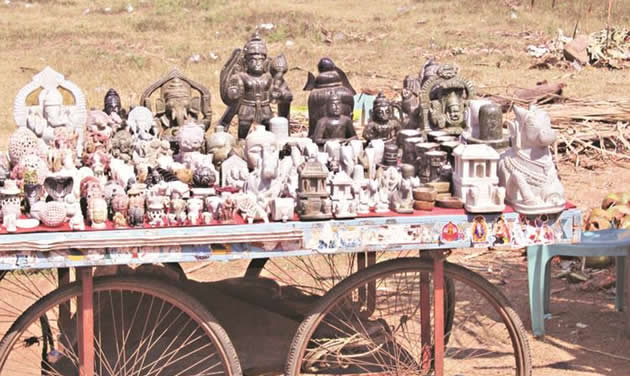The stone sculpture ‘vendors’


Crafters developing cheap duplicable artefacts are unlikely to go away immediately or anytime soon, thus jeopardising creativity
Knowledge Mushohwe Art Zone
Back in 1990, Syne Chikove, then the editor of the now defunct, The Artist tackled a problem that was only starting then, but has become even more widespread today.
Under the title “Distortion of Shona sculpture”, Chikove wrote warning the public about the danger being posed by what we have come to know as “airport” or “roadside” art.
The article lamented the lack of measures to curb the proliferation of diluted art at the expense of the acclaimed traditional Shona sculpture.
It is clear from the article that the problem alluded to was not a new one 25 years ago.
Chikove quoted a former National Gallery of Zimbabwe director, Frank McEwen, who in 1970 said; “Many of our original artists have dropped away into silence, or worse, joined the ranks of imitators, and such imitators inundate the field with an even more dishonest art — Airport art —which is vulgarly promoted by non-African exploiters.
“Fake production is already borrowing the most potent devices developed so far in the expectation that the distinction earned by successful artists will somehow sustain the commercial work of the unscrupulous hack.
“From a rich inherited potential, and the constant protection of the National Gallery, great Shona sculpture will progress as long as dedicated artists, and perhaps enlightened collectors and promoters, recognise the purity of its artistic intention.”
The problems of yesteryear have not gone away, but have in fact worsened.
The quality of “airport” or “roadside” art hardly improves — it is the amount of replicas that continues to increase relative to demand.
One ‘artist’, an old man that lived close to my home years back only made one product, mats inscribed with a ‘Home Sweet Home’ message.
He made probably thousands of the same product over and over again using the familiar template.
I doubt that the man enjoyed his job because repeating the same action several times tends to limit the creator.
It then becomes a simple matter of trying to earn a living minus the creativity, skill and technical knowhow associated with being an artist.
The imitators of today are certainly in the same boat.
They have become like the vendors flooding Harare’s central business district — individuals without a passion or skill for their job, but simply people trying to sell some product and hopefully feed their families.
And Roy Cook who in 1990 was the director of Matombo Gallery at the time observed that, “an artist is required to be dedicated to his work. Many people sculpting today are not sculptors at heart. They are not concerned to be original and creative. Too many are attracted to sculpting by the provision of earning a living.”
Originality or technical ability are not as important as earning a small profit to the Roadside artist.
It is as clear as rain that the problem of vending or selling of second hand clothes will continue to torment authorities, for as long as there continues to be a market for these disturbing products.
Similarly, crafters developing cheap duplicable artefacts are unlikely to go away immediately or anytime soon.
So should real art continue to lose out to the imitations in this day and age?
Indeed, roadside and airport art will continue to attract some customers essentially because it is way cheaper than authentic art.
Yet, arguably, most people that appreciate art would rather, regardless of the price discrepancies, own genuine artworks rather than cheap duplicates.
What then can be done to ensure that the authentic artworks get noticed by would-be customers?
For starters, original Shona Sculpture and other original Zimbabwe artwork be given exhibition space at the airports or other places of entry for tourists.
This way, foreign buyers get to see the real artworks first before they run into the fakes lined up on the roadsides.
Secondly, and perhaps more importantly, vigorous marketing strategies are needed so that Zimbabwe Art lovers all over the world get to know about the magical products on offer.
Back in 1990, Cook explained that, “Reece Galleries in New York saw the potential of (a marketing initiative) and have since spent a big deal of investment to establish (partnerships with) only serious Zimbabwean artists in the city. Every month, full page colour advertisements and quality brochures are placed in the most prominent art magazines.”
Now with the advent of the internet and its strong interactive services such as social networking, the platforms for marketing Zimbabwean stone sculpture are everywhere.
Local art galleries should also use their websites to market original stone and provide relevant information for the benefit of potential customers.
There is a big market for Zimbabwe stone sculpture out there, thanks to the works of great sculptors such as Henry Munyaradzi, Nicholas Mukomberanwa and Tapfuma Gutsa who opened the gates to a wider audience on both sides of the Atlantic.
Should more and more ‘artists’ opt for easy money by developing duplicates, however, the traditions set by our predecessors may be lost for good.









Comments